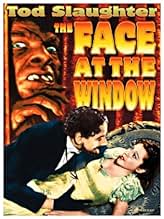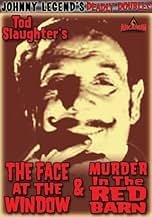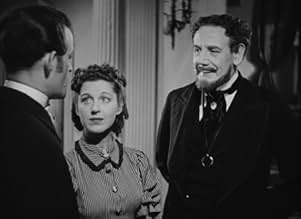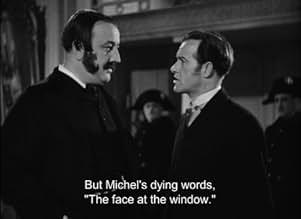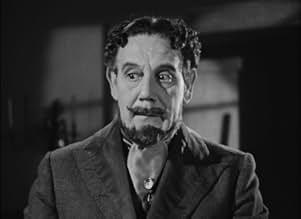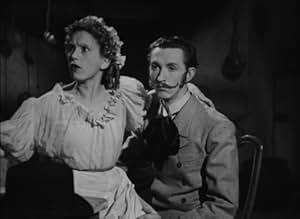Ajouter une intrigue dans votre langueSet in France in 1880. A series of murders is attributed to a Wolf Man.Set in France in 1880. A series of murders is attributed to a Wolf Man.Set in France in 1880. A series of murders is attributed to a Wolf Man.
- Réalisation
- Scénario
- Casting principal
Wallace Evennett
- Professor le Blanc
- (as Wallace Evenett)
Bill Shine
- Pierre
- (as Billy Shine)
Avis à la une
Tod Slaughter has to be one of the most reliably entertaining screen actors of the 30's. I've seen most of this guys films and he never disappoints. There's no doubt that his acting style is hammier than a hammy thing but there's nothing wrong with that surely? It takes considerable charisma and skill to overact as compellingly as Slaughter. This film follows a very similar narrative path to many of his other vehicles, i.e. Slaughter plays a rich pillar of the community who lives a double-life as an evil criminal, he lusts after a woman half his age who is not interested in him, so he sets about framing her fiancé with a crime he did not commit leaving the poor girl easy prey for him. Almost all his movies could be described thus. But it doesn't really seem to matter very much as Slaughter is always terrific as the leering cad and is easily the best thing about the films he stars in.
Slaughter's films were all Victorian melodramas first and foremost but this one definitely moves into more definite horror and even science fiction territory. The monster who is the face of the title is an effective looking baddie although he doesn't really get to do much and his presence in the movie doesn't make an awful lot of sense. But not to worry because, as I mentioned earlier, this is Slaughter's film and he delivers the goods as usual.
Slaughter's films were all Victorian melodramas first and foremost but this one definitely moves into more definite horror and even science fiction territory. The monster who is the face of the title is an effective looking baddie although he doesn't really get to do much and his presence in the movie doesn't make an awful lot of sense. But not to worry because, as I mentioned earlier, this is Slaughter's film and he delivers the goods as usual.
In THE FACE AT THE WINDOW, a murderer known as "The Wolf" is on the prowl in Paris, robbing and killing at will. Meanwhile, Chevalier. Lucio del Gardo (Tod Slaughter) sets out to marry a banker's daughter (Marjorie Taylor), who is much younger than he is.
No one plays these lecherous, wretched roles better than Mr. Slaughter! He's the Van Gogh of histrionic villainy! When del Gardo isn't busy killing people, he's framing his rival, so that he can wed the beautiful Cecile de Brisson (Marjorie Taylor).
Is this movie melodramatic to the extreme? Yes, but it's supposed to be. Mr. Slaughter's ham 'n' cheeeze approach fits in perfectly. We're treated to one of the Maestro's finest performances. This is highly entertaining stuff, complete with a nice mad science angle that comes in handy for the finale...
No one plays these lecherous, wretched roles better than Mr. Slaughter! He's the Van Gogh of histrionic villainy! When del Gardo isn't busy killing people, he's framing his rival, so that he can wed the beautiful Cecile de Brisson (Marjorie Taylor).
Is this movie melodramatic to the extreme? Yes, but it's supposed to be. Mr. Slaughter's ham 'n' cheeeze approach fits in perfectly. We're treated to one of the Maestro's finest performances. This is highly entertaining stuff, complete with a nice mad science angle that comes in handy for the finale...
Though you often read about the "quota quickies" made in Britain under a law that required a certain amount of screen time to be allotted to local product, you don't see many of them in America-- and for good reason: most were cranked out cheaply just to comply with the law, and are awful. In a few cases, however, the quota quickie laws provided opportunity for Britain's seemingly bottomless reserve of superior stage actors to be preserved on film-- that's why we have them to thank for Arthur Wontner's very fine Sherlock Holmes in some (not nearly as fine) Holmes movies, and it's also why we have a healthy collection of films starring the splendid ham Tod Slaughter, who toured for years as a ripsnorting baddie in authentic Victorian melodramas (such as Sweeney Todd) and transferred a number of them with minimal alteration to film. The Face at the Window is reportedly the highest-budgeted of Slaughter's films, and thus probably isn't technically a quota quickie at all, but it's still brought to the screen with the smell of fresh greasepaint straight from the provinces-- specifically the provinces circa 1895. Slaughter's larger than life performances give us as good a picture of what Victorian audiences ate up as the D'Oyly Carte company did of Gilbert and Sullivan's productions, because like them he was less reviving the old melodramas than carrying on their tradition intact. You may think you've seen people doing the Snidely Whiplash-style villain, and don't need to see them again, but you haven't lived until you've seen a seemingly sane and proper Slaughter dissolve in maniacal glee-- a-ha, ahahaha, ahahahahahahahahaha!
Tod Slaughter (1885-1956) was an unabashed and unapologetic purveyor of Victorian style stage melodrama. He had barnstormed throughout the English provinces during the early days of the Twentieth Century before serving in World War I.
By 1930, to stem the ever growing influx of Hollywood movies into England, a law was passed saying that 20% of all films had to be British made. In order to meet this goal, the "Quota Quickie" was established. These were essentially British B movies quickly and cheaply made to keep British artists and technicians employed. How they performed at the box office was of little concern.
Tod Slaughter's 8 QQ movies, shot between 1935-1940, were tailor made for that system. These were essentially his stage shows turned into film productions which were a cinematic capturing of a type of material and a style of performance that had flourished during the Victorian Era. This allows the viewer a glimpse into that time.
For those who have never seen him, think of Tod as a live action Snidely Whiplash (Dudley Do-Right's nemesis in ROCKY & BULLWINKLE). His most renowned film is SWEENEY TODD, THE DEMON BARBER OF FLEET STREET (1936) which served as the basis of the Stephen Sondheim musical (1979) and the Tim Burton movie with Johnny Depp (2007). Slaughter's most highly regarded movie (originally and today) is THE FACE IN THE WINDOW (1939).
The setting is 1880 Paris and a series of unsolved killings are committed by a criminal known only as "The Wolf" so called because right before a murder occurs the howl of a wolf is heard and a horrible visage is seen through a window. Could the mustache twirling, hand rubbing Chevalier Delgado be behind it all? We all know the answer to that question so it becomes a matter of going along for the ride and waiting for him to get his "just desserts".
This new restoration of FACE is part of a multi disc set. THE CRIMES OF TOD SLAUGHTER. Never has it or any of his other movies ever looked this good. If you would like to see the textbook definition of the word "Melodrama" then look no further. As Slaughter liked to say of his movies "They are full of "strong meat"...For more reviews visit The Capsule Critic.
By 1930, to stem the ever growing influx of Hollywood movies into England, a law was passed saying that 20% of all films had to be British made. In order to meet this goal, the "Quota Quickie" was established. These were essentially British B movies quickly and cheaply made to keep British artists and technicians employed. How they performed at the box office was of little concern.
Tod Slaughter's 8 QQ movies, shot between 1935-1940, were tailor made for that system. These were essentially his stage shows turned into film productions which were a cinematic capturing of a type of material and a style of performance that had flourished during the Victorian Era. This allows the viewer a glimpse into that time.
For those who have never seen him, think of Tod as a live action Snidely Whiplash (Dudley Do-Right's nemesis in ROCKY & BULLWINKLE). His most renowned film is SWEENEY TODD, THE DEMON BARBER OF FLEET STREET (1936) which served as the basis of the Stephen Sondheim musical (1979) and the Tim Burton movie with Johnny Depp (2007). Slaughter's most highly regarded movie (originally and today) is THE FACE IN THE WINDOW (1939).
The setting is 1880 Paris and a series of unsolved killings are committed by a criminal known only as "The Wolf" so called because right before a murder occurs the howl of a wolf is heard and a horrible visage is seen through a window. Could the mustache twirling, hand rubbing Chevalier Delgado be behind it all? We all know the answer to that question so it becomes a matter of going along for the ride and waiting for him to get his "just desserts".
This new restoration of FACE is part of a multi disc set. THE CRIMES OF TOD SLAUGHTER. Never has it or any of his other movies ever looked this good. If you would like to see the textbook definition of the word "Melodrama" then look no further. As Slaughter liked to say of his movies "They are full of "strong meat"...For more reviews visit The Capsule Critic.
Forget Karloff & Lugosi. Forget Cushing & Lee, even Price and the Chaneys. Tod is king of horror for one very important reason - he quite evidently enjoys his work. This was the first Tod film I saw and - having heard so much about him prior to this - I feared disappointment. No worries. Despite the cardboard settings and woeful support cast, from the moment he strides masterfully in, we are in the capable hands of a classic film villain. The opening murder with the eerie wolf howl on the soundtracks sets the scene perfectly and then we are treated to an acting masterclass from the great man himself. Whether innocently acting the concerned friend, lecherously trying to sneak a kiss from the heroine, threatening his low-life confederates with a grisly end if they cross him or, worst of all, holding somewhat one-sided conversations with his demented foster brother, Tod holds the film together. The Chevalier is underplayed by Tod compared to Sweeney Todd - but seldom has one man wiggled his eyebrows to more sinister effect. It's a great pity that Universal studios didn't try to to entice him over for their classic horror cycle - Tod would've made a far more spirited Dracula than John Carradine in the later sequels and can't you just see him going toe to toe with Basil Rathbone's Sherlock Holmes. Shame nobody thought of putting him up against Arthur Wontner's in the UK. The double-exposure effects for the appearance of the "face" are well done for their time and the whole film compares favourably with the Universal classics of the period.
The production values are far higher than is normal for a British quota quickie of the period. The contrast between the spacious elegant rooms of the moneyed classes and the clutter of the Blind Rat - with a wealth of extras and charming Parisian detail such as the dancers - more than foreshadows the class-consciousness Hammer brought to its gothics a few decades later. So does the violent action with Lucien using an oil lamp to devastating effect - his disguise as "Renard" could have been a bit more convincing - and Tod making a sudden getaway by leaping from the window of the scientist's house and swimming the Seine to safety. John Warwick and Marjorie Taylor make an appealing couple - although Warwick is no match for Eric Portman in the earlier melodramas - and George King is improving as a director with a tightly edited montage of tense faces as the "corpse" slowly stirs into action to write its incriminating message. Tod is less of a central figure with whom we are expected to side with - even through his setbacks - as Stephen Hawke and Sir Percival Glyde were, but is still a marvellously blackhearted villain, as seen in his unsporting behaviour at the duel with pistols with Lucien. This is his finest film.
The production values are far higher than is normal for a British quota quickie of the period. The contrast between the spacious elegant rooms of the moneyed classes and the clutter of the Blind Rat - with a wealth of extras and charming Parisian detail such as the dancers - more than foreshadows the class-consciousness Hammer brought to its gothics a few decades later. So does the violent action with Lucien using an oil lamp to devastating effect - his disguise as "Renard" could have been a bit more convincing - and Tod making a sudden getaway by leaping from the window of the scientist's house and swimming the Seine to safety. John Warwick and Marjorie Taylor make an appealing couple - although Warwick is no match for Eric Portman in the earlier melodramas - and George King is improving as a director with a tightly edited montage of tense faces as the "corpse" slowly stirs into action to write its incriminating message. Tod is less of a central figure with whom we are expected to side with - even through his setbacks - as Stephen Hawke and Sir Percival Glyde were, but is still a marvellously blackhearted villain, as seen in his unsporting behaviour at the duel with pistols with Lucien. This is his finest film.
Le saviez-vous
- AnecdotesOne of over 200 titles in the list of independent feature films made available for television presentation by Advance Television Pictures announced in "Motion Picture Herald", 4 April 1942. At this time, television broadcasting was in its infancy, almost totally curtailed by the advent of World War II, and would not continue to develop until 1945-46. Because of poor documentation (feature films were often not identified by title in conventional sources) no record has yet been found of its initial television broadcast. It's earliest documented USA telecasts took place on American Broadcasting Company's short-lived First Nighter Theatre, aired in New York City Wednesday 15 November 1950 on WJZ (Channel 9), in Los Angeles Tuesday 28 November 1950 on KECA (Channel 13), in San Francisco Monday 4 December 1950 on KGO (Channel 7) and in Philadelphia Friday 30 March 1951 on Friday TV Thriller on WCAU (Channel 10).
- ConnexionsFeatured in Phantom Ferris Theatre: Face at the Window (1959)
Meilleurs choix
Connectez-vous pour évaluer et suivre la liste de favoris afin de recevoir des recommandations personnalisées
- How long is The Face at the Window?Alimenté par Alexa
Détails
- Date de sortie
- Pays d’origine
- Langues
- Aussi connu sous le nom de
- Um Vulto na Janela
- Lieux de tournage
- Société de production
- Voir plus de crédits d'entreprise sur IMDbPro
- Durée1 heure 7 minutes
- Couleur
- Rapport de forme
- 1.37 : 1
Contribuer à cette page
Suggérer une modification ou ajouter du contenu manquant

